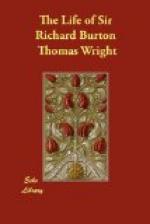unexpected moments; pious beasts—nay, the
very hills—praising Allah and glorifying
his vice-gerent; gullible saints, gifted scoundrels;
learned men with camel loads of dictionaries and classics,
thieves with camel loads of plunder; warriors, zanies,
necromancers, masculine women, feminine men, ghouls,
lutists, negroes, court poets, wags— the
central figure being the gorgeous, but truculent, Haroun
Al Rashid, who is generally accompanied by Ja’afer
and Masrur, and sometimes by the abandoned but irresistible
Abu Nowas. What magnificent trencher-folk they
all are! Even the love-lorn damsels. If
you ask for a snack between meals they send in a trifle
of 1,500 dishes.[FN#458] Diamonds and amethysts are
plentiful as blackberries. If you are a poet,
and you make good verses, it is likely enough that
some queen will stuff your mouth with balass rubies.
How poorly our modern means of locomotion compare
with those of the Nights. If you take a jinni
or a swan-maiden you can go from Cairo to Bokhara
in less time than our best expresses could cover a
mile. The recent battles between the Russians
and the Japanese are mere skirmishes compared with
the fight described in “The City of Brass”—where
700 million are engaged. The people who fare
worst in The Arabian Nights are those who pry into
what does not concern them or what is forbidden, as,
for example, that foolish, fatuous Third Kalendar,
and the equally foolish and fatuous Man who Never
Laughed Again;[FN#459] and perhaps The Edinburgh Review
was right in giving as the moral of the tales:
“Nothing is impossible to him who loves, provided”—and
the proviso is of crucial importance—“he
is not cursed with a spirit of curiosity.”
Few persons care, however, whether there is any moral
or not— most of us would as soon look for
one in the outstretched pride of a peacock’s
tale.
Where the dust of Shahrazad is kept tradition does
not tell us. If we knew we would hasten to her
tomb, and in imitation of the lover of Azizeh[FN#460]
lay thereon seven blood-red anemones.
134. The Blacksmith Who, etc.
Having glanced through the Nights, let us now compare
the two famous translations. As we have already
mentioned, Burton in his Translator’s Foreword
did not do Mr. Payne complete justice, but he pays
so many compliments to Mr. Payne’s translation
elsewhere that no one can suppose that he desired
to underrate the work of his friend. In the
Foreword he says that Mr. Payne “succeeds admirably
in the most difficult passages and often hits upon
choice and special terms and the exact vernacular
equivalent of the foreign word so happily and so picturesquely
that all future translators must perforce use the
same expression under pain of falling far short.”
Still this does not go far enough, seeing that, as
we said before, he made his translation very largely
a paraphrase of Payne’s. Consequently
he was able to get done in two broken years (April
1884 to April 1886) and with several other books in
hand, work that had occupied Mr. Payne six years (1876-1882).
Let us now take Mr. Payne’s rendering and Burton’s
rendering of two short tales and put them in juxtaposition.
The Blacksmith who could handle Fire without Hurt
and Abu Al Hasan and Abu Ja’afar the Leper will
suit our purpose admirably.




